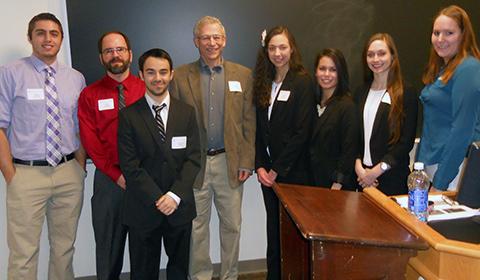Arcadia Students Present at Moravian Undergraduate Mathematics Conference

Eight Arcadia University students—including four mathematics majors, two biology majors, and two psychology majors—presented at the annual Moravian Undergraduate Mathematics Conference on Feb. 15. As has been the case the last four years, there were more student speakers from Arcadia than from any of the other 20 or so participating universities.
Titles and Abstracts
“Interpreting a three-way ANOVA interaction”
by AnnJosette Ramirez
Interpreting an interaction in two-way ANOVA is fairly straightforward. However, in a study I conducted analyzing the impact of an environmental toxicant on fruit fly larvae, I had three independent variables and encountered a significant three-way interaction. This talk focuses on my investigation to understand the meaning of this interaction.
“Parametric and non-parametric ANOVA”
by Amber K. Weiner
My analysis of data from a real-world experiment examining the impact of BPA exposure on fruit-fly larvae involved both parametric and non-parametric one-way ANOVA followed by appropriate post-hoc tests. I will discuss these statistical methods in the context of my data.
“Using R to compare the power of three techniques
for analyzing pretest-posttest designs.”
by Eric Loyack, Veronika Bailey, Yevgeniy Olkhov
Three common techniques for analyzing pretest-post-test designs involving one control and one treatment group are: t-test comparing posttest scores only, t-test comparing gain scores, and analysis of covariance. In this talk we give the results of our R-based simulations, which indicate that the relative power of the techniques is a function of the pretest/posttest correlation coefficient.
“Investigating how well Arcadia’s math placement test predicts future performance in calculus classes.”
by Stacie Lin Borell, Brian Innella
For years, Arcadia’s math department has used its own test to place incoming students into the appropriate math classes. However, ours was the first effort to collect and analyze data to see if the test is doing a good job. Our talk focuses on the results of this analysis.
“Investigating the Number Derivative Modulo n”
by Brianna Weiner
I will explore the concept of the number derivative (or the prime factorization of an integer) and primarily focus on its derivation modulo n. Through proving how to derive integers modulo powers of primes, we build toward an understanding of not only how to determine these number derivatives for any Zn, but also to count how many may exist on Zn.

